Mineralogy and Geochemistry of the Lower Cretaceous Coals in the Junde Mine, Hegang Coalfield, Northeastern China
Abstract
:1. Introduction
2. Geological Setting
3. Sampling and Analytical Techniques
4. Results
4.1. Coal Characteristics and Coal Petrology
4.2. Geochemical Features
4.2.1. Major Oxides (MEO)
4.2.2. Trace Elements
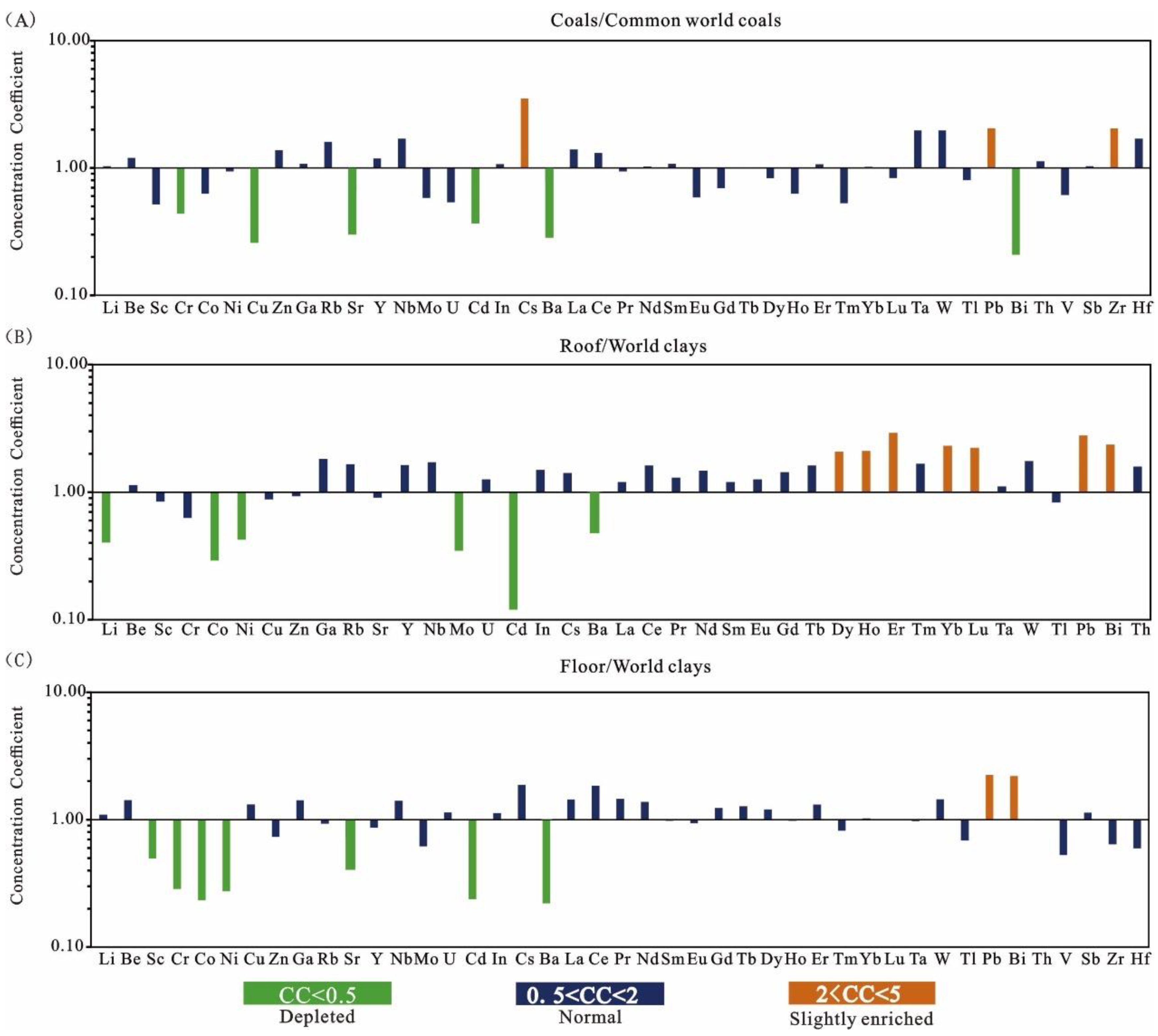
| Sample | Li | Be | Sc | Cr | Co | Ni | Cu | Zn | Ga | Rb | Sr | Y | Nb | Mo | U | Cd | In | Cs | Ba | La | Ce |
|---|---|---|---|---|---|---|---|---|---|---|---|---|---|---|---|---|---|---|---|---|---|
| JD-26-R | 22 | 3.4 | 13 | 69 | 5.5 | 20 | 32 | 83 | 29 | 221 | 217 | 51 | 19 | 0.56 | 5.4 | 0.11 | 0.09 | 18 | 221 | 58 | 122 |
| JD-26-01 | 19 | 4.3 | 4.1 | 4.9 | 7.1 | 11 | 3.4 | 32 | 11 | 65 | 52 | 29 | 11 | 1.3 | 2.0 | 0.14 | 0.08 | 13 | 51 | 28 | 52 |
| JD-26-02 | 7.5 | 3 | 1.5 | 5 | 4.3 | 10 | 4.5 | 16 | 4.3 | 16 | 42 | 6.7 | 4.6 | 0.83 | 0.89 | 0.04 | 0.02 | 2.0 | 47 | 6.4 | 14 |
| JD-26-03 | 16 | 1.7 | 1.4 | 6.6 | 1.4 | 9 | 5.4 | 21 | 6.4 | 16 | 35 | 6.3 | 4.5 | 1.3 | 0.98 | 0.03 | 0.02 | 2.0 | 66 | 9.9 | 22 |
| JD-26-04 | 23 | 1.6 | 2.9 | 14 | 1.7 | 16 | 2.8 | 43 | 9.3 | 55 | 27 | 12 | 6.8 | 1.1 | 2.2 | 0.15 | 0.03 | 7.2 | 35 | 42 | 72 |
| JD-26-05 | 4.8 | 1.1 | 1.1 | 4.5 | 2.4 | 21 | 2.4 | 22 | 4.2 | 5.9 | 23 | 6.5 | 4.7 | 0.91 | 0.86 | 0.06 | 0.03 | 0.45 | 28 | 8.5 | 17 |
| JD-26-06 | 4.6 | 0.62 | 0.87 | 4.8 | 1.7 | 5.7 | 3.6 | 57 | 4.1 | 5.1 | 27 | 4.8 | 8.1 | 1.6 | 0.56 | 0.11 | 0.02 | 0.58 | 27 | 6.0 | 12 |
| JD-26-07 | 8.1 | 1.3 | 1.7 | 5.9 | 2.8 | 10 | 3.7 | 19 | 4.5 | 4.4 | 31 | 6.7 | 3.9 | 1.8 | 1.1 | 0.05 | 0.02 | 0.42 | 34 | 7.8 | 19 |
| JD-26-08 | 17 | 1.9 | 2.6 | 10 | 4.1 | 14 | 6.2 | 43 | 6.7 | 17 | 27 | 9.0 | 6.8 | 1.5 | 1.7 | 0.06 | 0.05 | 3.4 | 55 | 15 | 34 |
| JD-26-F | 59 | 4.3 | 7.4 | 31 | 4.4 | 13 | 48 | 65 | 23 | 124 | 97 | 27 | 16 | 0.99 | 4.9 | 0.22 | 0.07 | 24 | 104 | 69 | 138 |
| Average- coal | 13 | 1.9 | 2.0 | 7.0 | 3.2 | 12 | 4.0 | 32 | 6.3 | 23 | 33 | 10 | 6.3 | 1.3 | 1.3 | 0.08 | 0.03 | 3.6 | 43 | 15 | 30 |
| world coal a | 12 | 1.6 | 3.9 | 16 | 5.1 | 13 | 16 | 23 | 5.8 | 14 | 110 | 8.4 | 3.7 | 2.2 | 2.4 | 0.22 | 0.03 | 1 | 150 | 11 | 23 |
| world clay b | 54 | 3 | 15 | 110 | 19 | 49 | 36 | 89 | 16 | 133 | 240 | 31 | 11 | 1.6 | 4.3 | 0.91 | 0.06 | 13 | 460 | 48 | 75 |
| Sample | Pr | Nd | Sm | Eu | Gd | Tb | Dy | Ho | Er | Tm | Yb | Lu | Ta | Tl | Pb | Bi | Th | V | Sb | Zr | Hf |
| JD-26-R | 13 | 53 | 9.6 | 1.5 | 8.3 | 1.4 | 9.2 | 1.9 | 5.6 | 0.84 | 5.8 | 0.87 | 1.6 | 1.1 | 39 | 0.9 | 22 | - | - | - | - |
| JD-26-01 | 5.9 | 23 | 4.1 | 0.40 | 3.6 | 0.68 | 4.2 | 0.86 | 2.5 | 0.42 | 2.6 | 0.441 | 1.7 | 0.496 | 34 | 0.244 | 9.3 | 12 | 2.2 | 205 | 7.0 |
| JD-26-02 | 1.5 | 5.9 | 1.1 | 0.18 | 1.0 | 0.19 | 1.1 | 0.21 | 0.59 | 0.11 | 0.74 | 0.11 | 0.26 | 0.29 | 7.0 | 0.08 | 2.2 | 14.8 | 1.8 | 40 | 0.98 |
| JD-26-03 | 2.4 | 8.6 | 1.6 | 0.18 | 1.3 | 0.23 | 1.1 | 0.23 | 0.73 | 0.11 | 0.78 | 0.13 | 0.42 | 0.35 | 14 | 0.16 | 3.2 | 16.5 | 0.39 | 46 | 1.3 |
| JD-26-04 | 7.7 | 26 | 4.1 | 0.62 | 3.8 | 0.53 | 2.6 | 0.41 | 1.3 | 0.20 | 1.2 | 0.168 | 0.53 | 0.57 | 8.5 | 0.33 | 3.9 | 20.9 | 0.57 | 44 | 1.3 |
| JD-26-05 | 2.0 | 7.2 | 1.3 | 0.16 | 1.1 | 0.20 | 1.1 | 0.23 | 0.65 | 0.12 | 0.70 | 0.11 | 0.26 | 0.25 | 4.9 | 0.07 | 2.5 | 5.7 | 0.31 | 66 | 1.5 |
| JD-26-06 | 1.4 | 5.4 | 1.0 | 0.11 | 0.84 | 0.16 | 0.88 | 0.17 | 0.50 | 0.08 | 0.48 | 0.08 | 0.61 | 0.32 | 4.3 | 0.07 | 1.6 | 9.5 | 0.48 | 70 | 1.5 |
| JD-26-07 | 2.2 | 9.0 | 1.7 | 0.22 | 1.4 | 0.24 | 1.2 | 0.25 | 0.77 | 0.12 | 0.69 | 0.13 | 0.24 | 0.54 | 14.6 | 0.23 | 2.4 | 13 | 0.90 | 47 | 1.1 |
| JD-26-08 | 3.5 | 14 | 2.5 | 0.35 | 2.1 | 0.34 | 1.9 | 0.35 | 0.94 | 0.16 | 1.0 | 0.17 | 0.48 | 1.2 | 39 | 0.43 | 4.7 | 29 | 1.0 | 72 | 1.8 |
| JD-26-F | 14.6 | 50 | 7.9 | 1.1 | 7.2 | 1.1 | 5.3 | 0.89 | 2.5 | 0.41 | 2.6 | 0.39 | 1.4 | 0.89 | 31 | 0.83 | 14 | 64 | 1.5 | 122 | 3.0 |
| Average-coal | 3.3 | 12 | 2.2 | 0.28 | 1.9 | 0.32 | 1.7 | 0.34 | 0.99 | 0.16 | 1.0 | 0.17 | 0.55 | 0.5 | 16 | 0.2 | 3.7 | 15 | 0.95 | 73 | 2.0 |
| world coal a | 3.5 | 12 | 2 | 0.47 | 2.7 | 0.32 | 2.1 | 0.54 | 0.93 | 0.31 | 1.0 | 0.2 | 0.28 | 0.63 | 7.8 | 0.97 | 3.3 | 25 | 0.92 | 36 | 1.2 |
| world clay b | 10 | 36 | 8 | 1.2 | 5.8 | 0.83 | 4.4 | 0.9 | 1.9 | 0.5 | 2.5 | 0.39 | 1.4 | 1.3 | 14 | 0.38 | 14 | 120 | 1.3 | 190 | 5 |
4.2.3. Rare Earth Elements and Yttrium (REY)
4.3. Mineralogy
4.3.1. Clay Minerals
4.3.2. Quartz
4.3.3. Pyrite
4.3.4. Carbonate Minerals
4.3.5. Other Minerals
5. Discussion
5.1. Sediment Source
5.2. Sedimentary Environment
5.3. Influence of Volcanic Ash
6. Conclusions
- (1)
- The No. 26 coal of Junde mine is slightly enriched in Cs, Pb, and Zr. From the vertical section of No. 26 coal seams, the contents of Cs, Pb, and Zr in the coal samples near the host rocks (roof and floor) outclass those in the middle coal seams.
- (2)
- The minerals in Junde coals mainly include clay minerals and quartz, followed by calcite, siderite, pyrite, monazite, and zircon.
- (3)
- The terrigenous components in No. 26 coal from Junde mine were derived from the Late Paleozoic meta-igneous rocks in the Jiamusi block evidenced by Sr/Y, La/Yb, and Al2O3/TiO2 ratios, Zr/Sc—Th/Sc plot, and negative Eu anomalies.
- (4)
- The No. 26 coal from the Junde mine was affected by fresh water during coal formation. Sulfate sulfur indicate oxidation/evaporation gradually decreases during No. 26 coal formation.
- (5)
- The volcanic ash contribution to No. 26 coal seems very low, if occurred.
Author Contributions
Funding
Institutional Review Board Statement
Informed Consent Statement
Data Availability Statement
Conflicts of Interest
References
- Finkelman, R.B.; Dai, S.; French, D. The importance of minerals in coal as the hosts of chemical elements: A review. Int. J. Coal Geol. 2019, 212, 103251. [Google Scholar] [CrossRef]
- Dai, S.; Finkelman, R.B. Coal as a promising source of critical elements: Progress and future prospects. Int. J. Coal Geol. 2018, 186, 155–164. [Google Scholar] [CrossRef]
- Seredin, V.V.; Dai, S.; Sun, Y.; Chekryzhov, I.Y. Coal deposits as promising sources of rare metals for alternative power and energy-efficient technologies. Appl. Geochem. 2013, 31, 1–11. [Google Scholar] [CrossRef]
- Dai, S.; Finkelman, R.B.; French, D.; Hower, J.C.; Graham, I.T.; Zhao, F. Modes of occurrence of elements in coal: A critical evaluation. Earth-Sci. Rev. 2021, 222, 103815. [Google Scholar] [CrossRef]
- Liu, J.; Dai, S.; Song, H.; Nechaev, V.P.; French, D.; Spiro, B.F.; Graham, I.T.; Hower, J.C.; Shao, L.; Zhao, J. Geological factors controlling variations in the mineralogical and elemental compositions of Late Permian coals from the Zhijin-Nayong Coalfield, western Guizhou, China. Int. J. Coal Geol. 2021, 247, 103855. [Google Scholar] [CrossRef]
- Dai, S.; Chekryzhov, I.Y.; Seredin, V.V.; Nechaev, V.P.; Graham, I.T.; Hower, J.C.; Ward, C.R.; Ren, D.; Wang, X. Metalliferous coal deposits in East Asia (Primorye of Russia and South China): A review of geodynamic controls and styles of mineralization. Gondwana Res. 2016, 29, 60–82. [Google Scholar] [CrossRef]
- Seredin, V.V.; Finkelman, R.B. Metalliferous coals: A review of the main genetic and geochemical types. Int. J. Coal Geol. 2008, 76, 253–289. [Google Scholar] [CrossRef]
- Chehreh Chelgani, S.; Hower, J.C. Estimating REY content of eastern Kentucky coal samples based on their associated ash elements. J. Rare Earths 2018, 36, 1234–1238. [Google Scholar] [CrossRef]
- Taggart, R.K.; Hower, J.C.; Hsu-Kim, H. Effects of roasting additives and leaching parameters on the extraction of rare earth elements from coal fly ash. Int. J. Coal Geol. 2018, 196, 106–114. [Google Scholar] [CrossRef]
- Kolker, A.; Hower, J.C.; Karamalidis, A.K. Introduction to critical elements in coal and coal ash and their recovery, a virtual special issue. Int. J. Coal Geol. 2019, 206, 19–20. [Google Scholar] [CrossRef]
- Arbuzov, S.; Chekryzhov, I.; Finkelman, R.; Sun, Y.; Zhao, C.; Il’Enok, S.; Blokhin, M.; Zarubina, N. Comments on the geochemistry of rare-earth elements (La, Ce, Sm, Eu, Tb, Yb, Lu) with examples from coals of north Asia (Siberia, Russian far East, North China, Mongolia, and Kazakhstan). Int. J. Coal Geol. 2019, 206, 106–120. [Google Scholar] [CrossRef]
- Bagdonas, D.; Enriquez, A.; Coddington, K.; Finnoff, D.; McLaughlin, J.; Bazilian, M.; Phillips, E.; McLing, T. Rare earth element resource evaluation of coal byproducts: A case study from the Powder River Basin, Wyoming. Renew. Sustain. Energy Rev. 2022, 158, 112148. [Google Scholar] [CrossRef]
- Zhou, M.; Zhao, L.; Wang, X.; Nechaev, V.P.; French, D.; Spiro, B.F.; Graham, I.T.; Hower, J.C.; Dai, S. Mineralogy and geochemistry of the Late Triassic coal from the Caotang mine, northeastern Sichuan Basin, China, with emphasis on the enrichment of the critical element lithium. Ore Geol. Rev. 2021, 139, 104582. [Google Scholar] [CrossRef]
- Hu, S.; Ni, Y.; Yin, Q.; Wang, J.; Lv, L.; Cen, K.; Zhou, H. Research on element migration and ash deposition characteristics of high-alkali coal in horizontal liquid slagging cyclone furnace. Fuel 2022, 308, 121962. [Google Scholar] [CrossRef]
- Sutcu, E.C.; Şentürk, S.; Kapıcı, K.; Gökçe, N. Mineral and rare earth element distribution in the Tunçbilek coal seam, Kütahya, Turkey. Int. J. Coal Geol. 2021, 245, 103820. [Google Scholar] [CrossRef]
- Hower, J.C.; Eble, C.F.; Xie, P.; Liu, J.; Fu, B.; Hood, M.M. Aspects of rare earth element enrichment in Allegheny Plateau coals, Pennsylvania, USA. Appl. Geochem. 2022, 136, 105150. [Google Scholar] [CrossRef]
- Kolker, A.; Scott, C.; Lefticariu, L.; Mastalerz, M.; Drobniak, A.; Scott, A. Trace element partitioning during coal preparation: Insights from U.S. Illinois Basin coals. Int. J. Coal Geol. 2021, 243, 103781. [Google Scholar] [CrossRef]
- Lei, Z.; Cheng, Z.; Ling, Q.; Liu, X.; Cui, P.; Zhao, Z. Investigating the trigger mechanism of Shenfu bituminous coal pyrolysis. Fuel 2022, 313, 122995. [Google Scholar] [CrossRef]
- Wang, X.; Bian, J.; Zeng, F.; Pan, Z.; Chai, P. Aluminum-bearing nano-sized minerals in vitrain band and its implications for modes of occurrence of Al in Carboniferous-Permian coals from the Hedong Coalfield, northern China. Int. J. Coal Geol. 2021, 248, 103861. [Google Scholar] [CrossRef]
- BaiLin, Y.; XiaoFeng, J. An Investigation on Configuration status of Science and Technology Resource in the Coal Industry of Heilongjiang Province. Energy Procedia 2011, 5, 2167–2171. [Google Scholar] [CrossRef] [Green Version]
- Zhang, Y.; Sun, Y.; Qin, J. Sustainable development of coal cities in Heilongjiang province based on AHP method. Int. J. Min. Sci. Technol. 2012, 22, 133–137. [Google Scholar] [CrossRef]
- Dai, S.; Ren, D.; Chou, C.-L.; Finkelman, R.B.; Seredin, V.V.; Zhou, Y. Geochemistry of trace elements in Chinese coals: A review of abundances, genetic types, impacts on human health, and industrial utilization. Int. J. Coal Geol. 2012, 94, 3–21. [Google Scholar] [CrossRef]
- Zhao, L.; Ward, C.R.; French, D.; Graham, I.T. Mineralogical composition of Late Permian coal seams in the Songzao Coalfield, southwestern China. Int. J. Coal Geol. 2013, 116–117, 208–226. [Google Scholar] [CrossRef]
- Zhuang, X.; Querol, X.; Alastuey, A.; Plana, F.; Moreno, N.; Andrés, J.M.; Wang, J. Mineralogy and geochemistry of the coals from the Chongqing and Southeast Hubei coal mining districts, South China. Int. J. Coal Geol. 2007, 71, 263–275. [Google Scholar] [CrossRef]
- Jiu, B.; Huang, W.; Mu, N. Mineralogy and elemental geochemistry of Permo-Carboniferous Li-enriched coal in the southern Ordos Basin, China: Implications for modes of occurrence, controlling factors and sources of Li in coal. Ore Geol. Rev. 2022, 141, 104686. [Google Scholar] [CrossRef]
- Pan, J.; Ge, T.; Liu, W.; Wang, K.; Wang, X.; Mou, P.; Wu, W.; Niu, Y. Organic matter provenance and accumulation of transitional facies coal and mudstone in Yangquan, China: Insights from petrology and geochemistry. J. Nat. Gas Sci. Eng. 2021, 94, 104076. [Google Scholar] [CrossRef]
- Wei, Y.; He, W.; Qin, G.; Fan, M.; Cao, D. Lithium Enrichment in the No. 21 Coal of the Hebi No. 6 Mine, Anhe Coalfield, Henan Province, China. Minerals 2020, 10, 521. [Google Scholar] [CrossRef]
- Qin, G.; Cao, D.; Wei, Y.; Wang, A.; Liu, J. Geochemical characteristics of the Permian coals in the Junger-Hebaopian mining district, northeastern Ordos Basin, China: Key role of paleopeat-forming environments in Ga-Li-REY enrichment. J. Geochem. Explor. 2020, 213, 106494. [Google Scholar] [CrossRef]
- Qin, G.; Cao, D.; Wei, Y.; Wang, A.; Liu, J. Mineralogy and Geochemistry of the No. 5-2 High-Sulfur Coal from the Dongpo Mine, Weibei Coalfield, Shaanxi, North China, with Emphasis on Anomalies of Gallium and Lithium. Minerals 2019, 9, 402. [Google Scholar] [CrossRef] [Green Version]
- Zhuang, X.; Querol, X.; Alastuey, A.; Juan, R.; Plana, F.; Lopez-Soler, A.; Du, G.; Martynov, V.V. Geochemistry and mineralogy of the Cretaceous Wulantuga high-germanium coal deposit in Shengli coal field, Inner Mongolia, Northeastern China. Int. J. Coal Geol. 2006, 66, 119–136. [Google Scholar] [CrossRef]
- Qi, H.; Hu, R.; Zhang, Q. REE Geochemistry of the Cretaceous lignite from Wulantuga Germanium Deposit, Inner Mongolia, Northeastern China. Int. J. Coal Geol. 2007, 71, 329–344. [Google Scholar] [CrossRef]
- Shao, L.; Hou, H.; Tang, Y.; Lu, J.; Qiu, H.; Wang, X.; Zhang, J. Selection of strategic replacement areas for CBM exploration and development in China. Nat. Gas Ind. B 2015, 2, 211–221. [Google Scholar] [CrossRef] [Green Version]
- Guo, W.; Dai, S.; Nechaev, V.P.; Nechaeva, E.V.; Wei, G.; Finkelman, R.B.; Spiro, B.F. Geochemistry of Palaeogene coals from the Fuqiang Mine, Hunchun Coalfield, northeastern China: Composition, provenance, and relation to the adjacent polymetallic deposits. J. Geochem. Explor. 2019, 196, 192–207. [Google Scholar] [CrossRef]
- Guo, W.; Nechaev, V.; Yan, X.; Yang, C.; He, X.; Shan, K.; Nechaeva, E.V. New data on geology and germanium mineralization in the Hunchun Basin, northeastern China. Ore Geol. Rev. 2019, 107, 381–391. [Google Scholar] [CrossRef]
- Dai, S.; Guo, W.; Nechaev, V.P.; French, D.; Ward, C.R.; Spiro, B.F.; Finkelman, R.B. Modes of occurrence and origin of mineral matter in the Palaeogene coal (No. 19-2) from the Hunchun Coalfield, Jilin Province, China. Int. J. Coal Geol. 2018, 189, 94–110. [Google Scholar] [CrossRef]
- Nechaev, V.P.; Bechtel, A.; Dai, S.; Chekryzhov, I.; Pavlyutkin, B.I.; Vysotskiy, S.V.; Ignatiev, A.V.; Velivetskaya, T.A.; Guo, W.; Tarasenko, I.; et al. Bio-geochemical evolution and critical element mineralization in the Cretaceous-Cenozoic coals from the southern Far East Russia and northeastern China. Appl. Geochem. 2020, 117, 104602. [Google Scholar] [CrossRef]
- Yang, Z.R.; Jiang, J.H. Depositional environments of the shitouhezi formation and its characteristics of the episodic coal accumulation,upper jurassic hegang basin,heilongjiang province. Acta Sedimentol. Sin 1997, 15, 58–63. [Google Scholar]
- Li, Z.; Shao, L.Y.; Li, M.; Gao, D.; Zhen, M.Q. Analysis on the sequence stratigraphy and coal accumulation of shitouhezi formation in hegang coal basin. J. Beijing Polytech. Coll. 2011, 10, 11–17. [Google Scholar]
- ASTM Standard D3173-11; Test Method for Moisture in the Analysis Sample of Coal and Coke. Annual Book of ASTM Standards. ASTM International: West Conshohocken, PA, USA, 2011.
- ASTM Standard D3174-11; Test Method for Ash in the Analysis Sample of Coal and Coke. Annual Book of ASTM Standards. ASTM International: West Conshohocken, PA, USA, 2011.
- ASTM Standard D3175-11; Test Method for Volatile Matter in the Analysis Sample of Coal and Coke. Annual Book of ASTM Standards. ASTM International: West Conshohocken, PA, USA, 2011.
- International Committee for Coal and Organic Petrology (ICCP). The new inertinite classification (ICCP System 1994). Fuel 2001, 80, 459–471. [Google Scholar] [CrossRef]
- International Committee for Coal and Organic Petrology (ICCP). The new vitrinite classification (ICCP System 1994). Fuel 1998, 77, 349–358. [Google Scholar] [CrossRef]
- Pickel, W.; Kus, J.; Flores, D.; Kalaitzidis, S.; Christanis, K.; Cardott, B.; Misz-Kennan, M.; Rodrigues, S.; Hentschel, A.; Hamor-Vido, M.; et al. Classification of liptinite—ICCP System 1994. Int. J. Coal Geol. 2017, 169, 40–61. [Google Scholar] [CrossRef] [Green Version]
- ASTM Standard D3177-02; Test Methods for Total Sulfur in the Analysis Sample of Coal and Coke. ASTM International: West Conshohocken, PA, USA, 2011.
- ASTM D2492-02; Standard Test Method for Forms of Sulfur in Coal. ASTM International: West Conshohocken, PA, USA, 2012.
- Dai, S.; Wang, X.; Zhou, Y.; Hower, J.C.; Li, D.; Chen, W.; Zhu, X.; Zou, J. Chemical and mineralogical compositions of silicic, mafic, and alkali tonsteins in the late Permian coals from the Songzao Coalfield, Chongqing, Southwest China. Chem. Geol. 2011, 282, 29–44. [Google Scholar] [CrossRef]
- Dai, S.; Li, T.; Jiang, Y.; Ward, C.R.; Hower, J.C.; Sun, J.; Liu, J.; Song, H.; Wei, J.; Li, Q.; et al. Mineralogical and geochemical compositions of the Pennsylvanian coal in the Hailiushu Mine, Daqingshan Coalfield, Inner Mongolia, China: Implications of sediment-source region and acid hydrothermal solutions. Int. J. Coal Geol. 2015, 137, 92–110. [Google Scholar] [CrossRef]
- GB15224.1-2010; Classification for Quality of Coal-Part 1: Ash. Standand Press of China: Beijing, China, 2010.
- GB15224.2-2010; Classification for Quality of Coal-Part 2: Sulfur Content. Standand Press of China: Beijing, China, 2010.
- Hower, J.C.; O’Keefe, J.M.K.; Wagner, N.J.; Dai, S.; Wang, X.; Xue, W. An investigation of Wulantuga coal (Cretaceous, Inner Mongolia) macerals: Paleopathology of faunal and fungal invasions into wood and the recognizable clues for their activity. Int. J. Coal Geol. 2013, 114, 44–53. [Google Scholar] [CrossRef]
- Hower, J.C.; Misz-Keenan, M.; O’Keefe, J.M.; Mastalerz, M.; Eble, C.F.; Garrison, T.M.; Johnston, M.N.; Stucker, J. Macrinite forms in Pennsylvanian coals. Int. J. Coal Geol. 2013, 116–117, 172–181. [Google Scholar] [CrossRef]
- Ketris, M.P.; Yudovich, Y.E. Estimations of Clarkes for Carbonaceous biolithes: World averages for trace element contents in black shales and coals. Int. J. Coal Geol. 2009, 78, 135–148. [Google Scholar] [CrossRef]
- Grigoriev, N.A. Chemical Element Distribution in the Upper Continental Crust; UB RAS: Ekaterinburg, Russia, 2009. [Google Scholar]
- Seredin, V.V.; Dai, S. Coal deposits as potential alternative sources for lanthanides and yttrium. Int. J. Coal Geol. 2012, 94, 67–93. [Google Scholar] [CrossRef]
- Dai, S.; Graham, I.T.; Ward, C.R. A review of anomalous rare earth elements and yttrium in coal. Int. J. Coal Geol. 2016, 159, 82–95. [Google Scholar] [CrossRef]
- Yan, X.; Dai, S.; Graham, I.T.; He, X.; Shan, K.; Liu, X. Determination of Eu concentrations in coal, fly ash and sedimentary rocks using a cation exchange resin and inductively coupled plasma mass spectrometry (ICP-MS). Int. J. Coal Geol. 2018, 191, 152–156. [Google Scholar] [CrossRef]
- Taylor, S.R.; McLennan, S.M. The geochemical evolution of the continental crust. Rev. Geophys. 1995, 33, 241–265. [Google Scholar] [CrossRef]
- Dai, S.; Ward, C.R.; Graham, I.T.; French, D.; Hower, J.C.; Zhao, L.; Wang, X. Altered volcanic ashes in coal and coal-bearing sequences: A review of their nature and significance. Earth-Sci. Rev. 2017, 175, 44–74. [Google Scholar] [CrossRef]
- Dai, S.; Ren, D.; Hou, X.; Shao, L. Geochemical and mineralogical anomalies of the late Permian coal in the Zhijin coalfield of southwest China and their volcanic origin. Int. J. Coal Geol. 2003, 55, 117–138. [Google Scholar] [CrossRef]
- Li, J.; Zhuang, X.; Querol, X.; Font, O.; Izquierdo, M.; Wang, Z. New data on mineralogy and geochemistry of high-Ge coals in the Yimin coalfield, Inner Mongolia, China. Int. J. Coal Geol. 2014, 125, 10–21. [Google Scholar] [CrossRef]
- Hayashi, K.I.; Fujisawa, H.; Holland, H.D.; Ohmoto, H. Geochemistry of approximately 1.9 Ga sedimentary rocks from northeastern Labrador, Canada. Geochim. Cosmochim. Acta 1997, 61, 4115–4137. [Google Scholar] [CrossRef]
- He, B.; Xu, Y.-G.; Zhong, Y.-T.; Guan, J.-P. The Guadalupian Lopingian boundary mudstones at Chaotian (SW China) are clastic rocks rather than acidic tuffs: Implication for a temporal coincidence between the end-Guadalupian mass extinction and the Emeishan volcanism. Lithos 2010, 119, 10–19. [Google Scholar] [CrossRef]
- Mclennan, S.M. Geochemical approaches to sedimentation, provenance, and tectonics. Processes Controlling the Composition of Clastic Sediments. Geol. Soc. Am. Spec. Pap. 1993, 284, 21. [Google Scholar]
- Yang, N.; Tang, S.-H.; Zhang, S.-H.; Xi, Z.-D.; Li, J.; Yuan, Y.; Guo, Y.-Y. In seam variation of element-oxides and trace elements in coal from the eastern Ordos Basin, China. Int. J. Coal Geol. 2018, 197, 31–41. [Google Scholar] [CrossRef]
- Bi, J.-H.; Ge, W.-C.; Yang, H.; Wang, Z.-H.; Dong, Y.; Liu, X.-W.; Ji, Z. Age, petrogenesis, and tectonic setting of the Permian bimodal volcanic rocks in the eastern Jiamusi Massif, NE China. J. Asian Earth Sci. 2017, 134, 160–175. [Google Scholar] [CrossRef]
- Tang, J.; Xu, W.-L.; Wang, F.; Wang, W.; Xu, M.-J.; Zhang, Y.-H. Geochronology and geochemistry of Neoproterozoic magmatism in the Erguna Massif, NE China: Petrogenesis and implications for the breakup of the Rodinia supercontinent. Precambrian Res. 2013, 224, 597–611. [Google Scholar] [CrossRef]
- Ji, W.; Xu, W.; Yang, D.; Pei, F.; Jin, K.; Liu, X. Chronology and geochemistry of volcanic rocks in the Cretaceous Suifenhe Formation in eastern Heilongjiang, China. Acta Geol. Sin. 2007, 81, 266–277. [Google Scholar]
- Luan, J.-P.; Xu, W.-L.; Wang, F.; Wang, Z.-W.; Guo, P. Age and geochemistry of Neoproterozoic granitoids in the Songnen–Zhangguangcai Range Massif, NE China: Petrogenesis and tectonic implications. J. Asian Earth Sci. 2017, 148, 265–276. [Google Scholar] [CrossRef]
- Sun, M.; Chen, H.; Zhang, F.; Wilde, S.; Minna, A.; Lin, X.; Yang, S. Cretaceous provenance change in the Hegang Basin and its connection with the Songliao Basin, NE China: Evidence for lithospheric extension driven by palaeo-Pacific roll-back. Geol. Soc. Lond. Spec. Publ. 2015, 413, 91–117. [Google Scholar] [CrossRef] [Green Version]
- Zhao, L.; Dai, S.; Nechaev, V.P.; Nechaeva, E.V.; Graham, I.T.; French, D.; Sun, J. Enrichment of critical elements (Nb-Ta-Zr-Hf-REE) within coal and host rocks from the Datanhao mine, Daqingshan Coalfield, northern China. Ore Geol. Rev. 2019, 111, 102951. [Google Scholar] [CrossRef]
- Dai, S.; Bechtel, A.; Eble, C.F.; Flores, R.M.; French, D.; Graham, I.T.; Hood, M.M.; Hower, J.C.; Korasidis, V.A.; Moore, T.A.; et al. Recognition of peat depositional environments in coal: A review. Int. J. Coal Geol. 2020, 219, 103383. [Google Scholar] [CrossRef]
- Wang, A.; Wang, Z.; Liu, J.; Xu, N.; Li, H. The Sr/Ba ratio response to salinity in clastic sediments of the Yangtze River Delta. Chem. Geol. 2021, 559, 119923. [Google Scholar] [CrossRef]
- Wang, A.H. Discriminant effect of sedimentary environment by the Sr/Ba ratio of different existing forms. Acta Sedimentol. Sin. 1996, 14, 168–173, (In Chinese with English abstract). [Google Scholar]
- Ge, W.; Wu, F.; Zhou, C.; Zhang, J. Porphyry Cu-Mo deposits in the eastern Xing’an-Mongolian Orogenic Belt: Mineralization ages and their geodynamic implications. Chin. Sci. Bull. 2007, 52, 3416–3427. [Google Scholar] [CrossRef]
- Zhou, Y.; Ren, Y.; Tang, D.; Bohor, B. Characteristics of zircons from volcanic ash-derived tonsteins in Late Permian coal fields of eastern Yunnan, China. Int. J. Coal Geol. 1994, 25, 243–264. [Google Scholar] [CrossRef]
- Zhou, Y.; Bohor, B.F.; Ren, Y. Trace element geochemistry of altered volcanic ash layers (tonsteins) in Late Permian coal-bearing formations of eastern Yunnan and western Guizhou Provinces, China. Int. J. Coal Geol. 2000, 44, 305–324. [Google Scholar] [CrossRef]
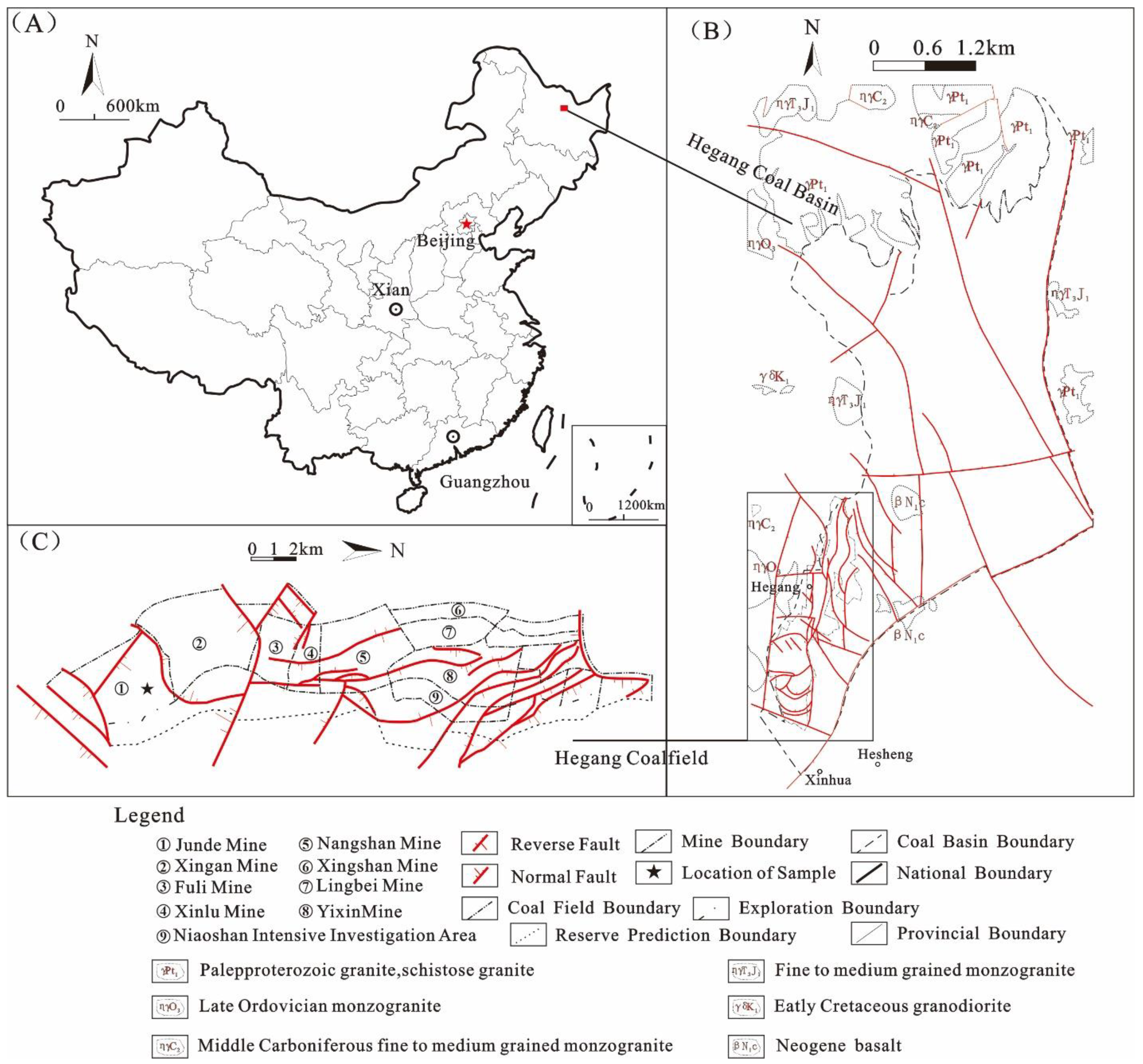
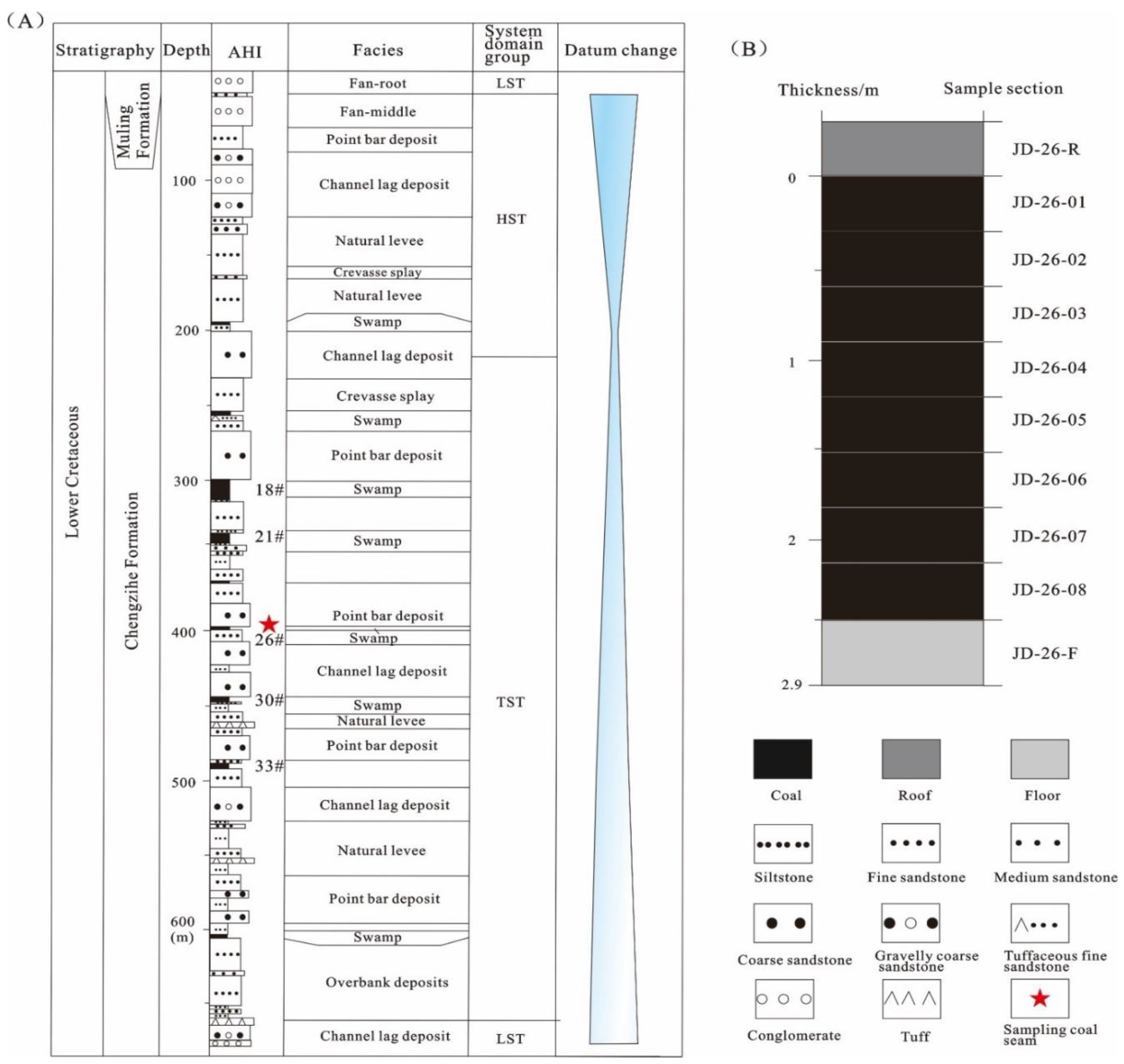
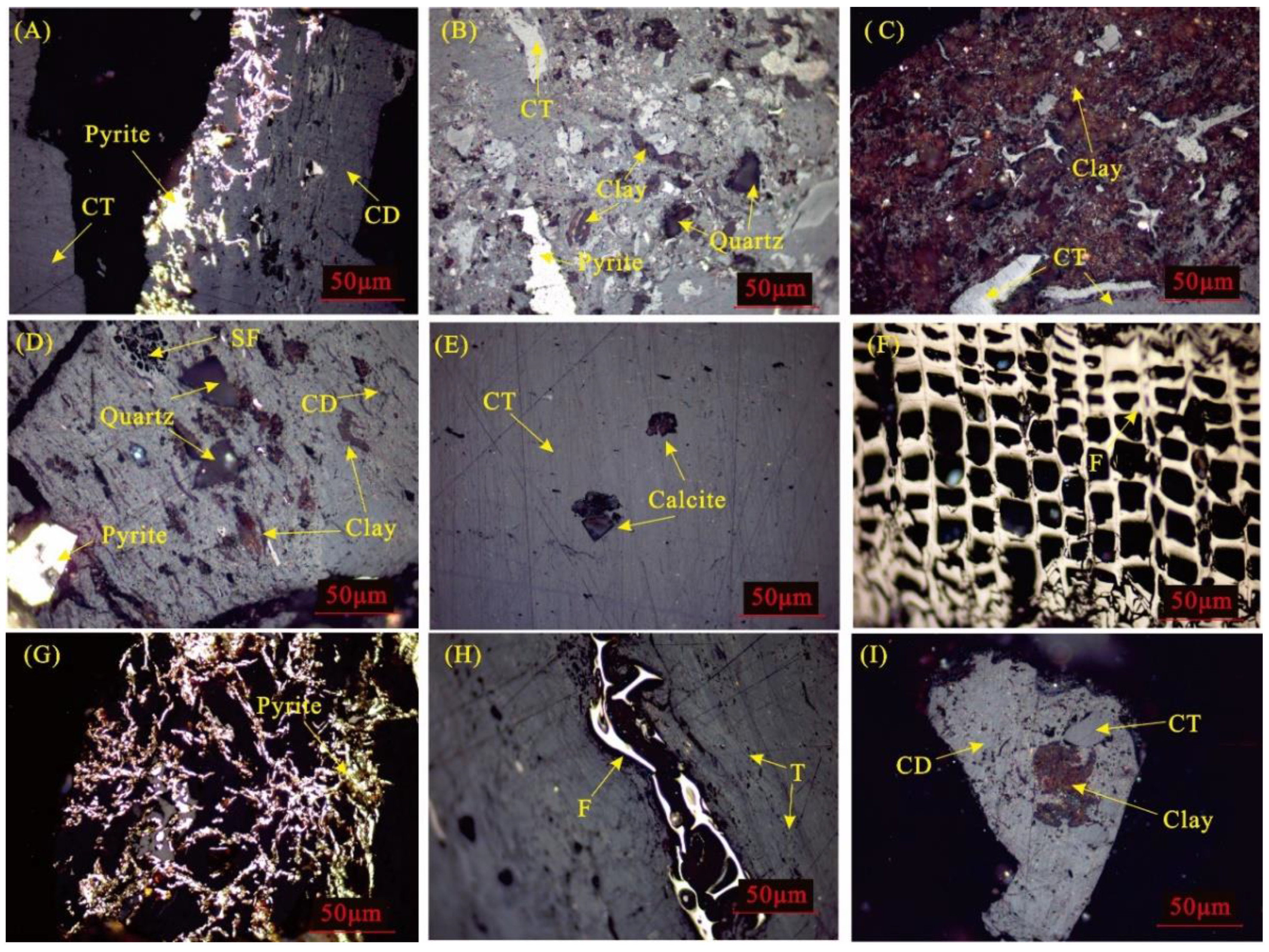



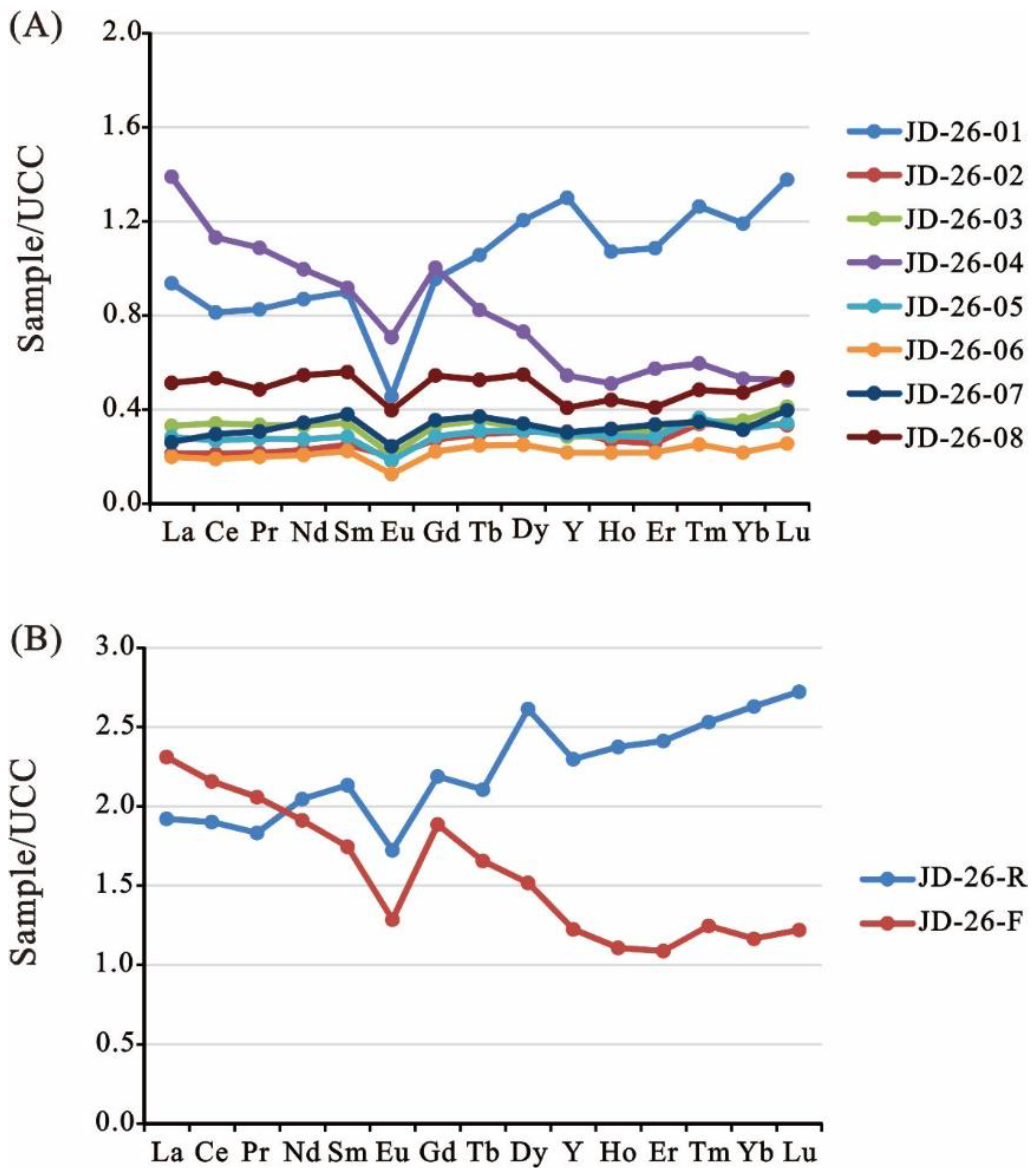


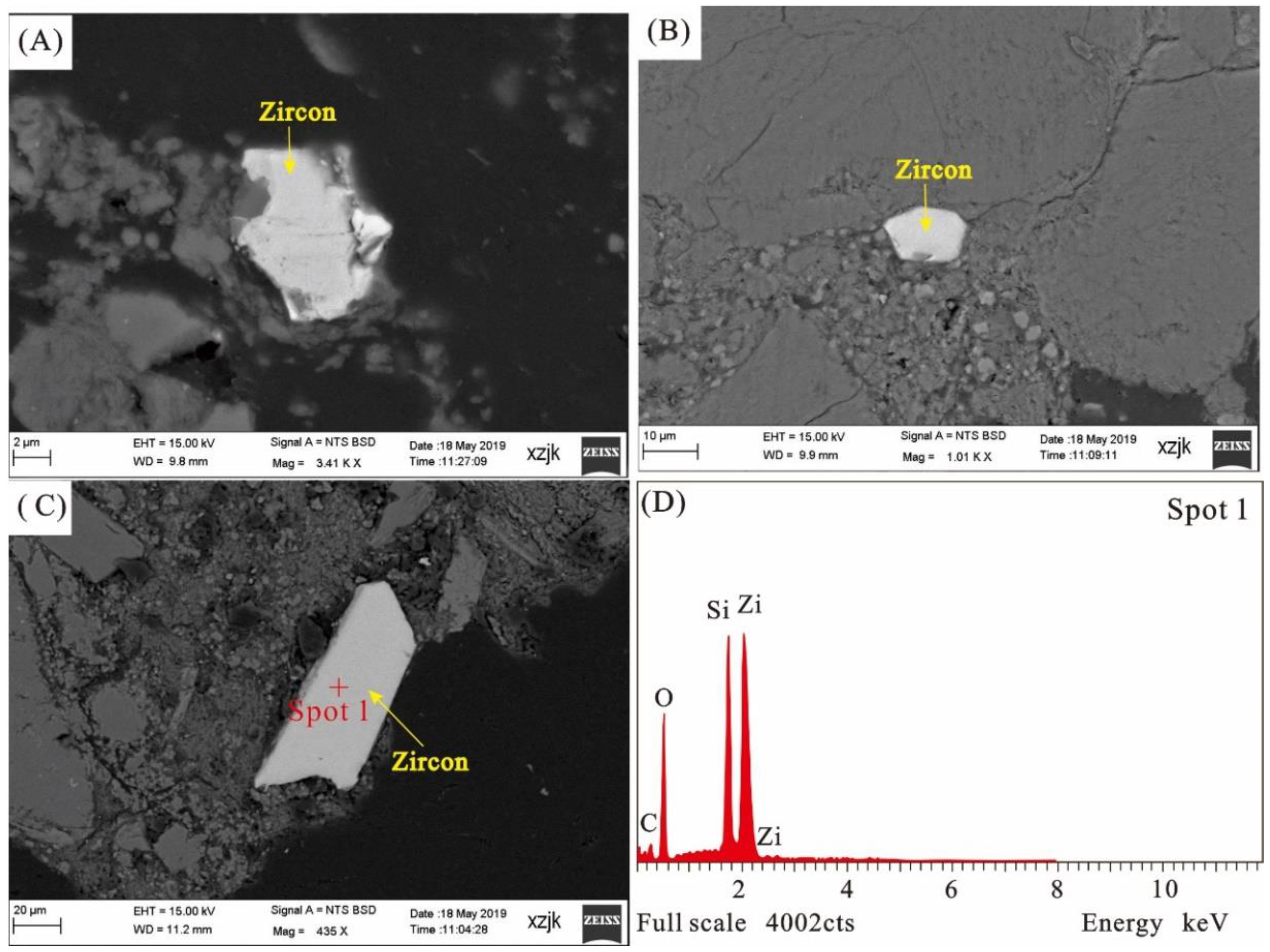
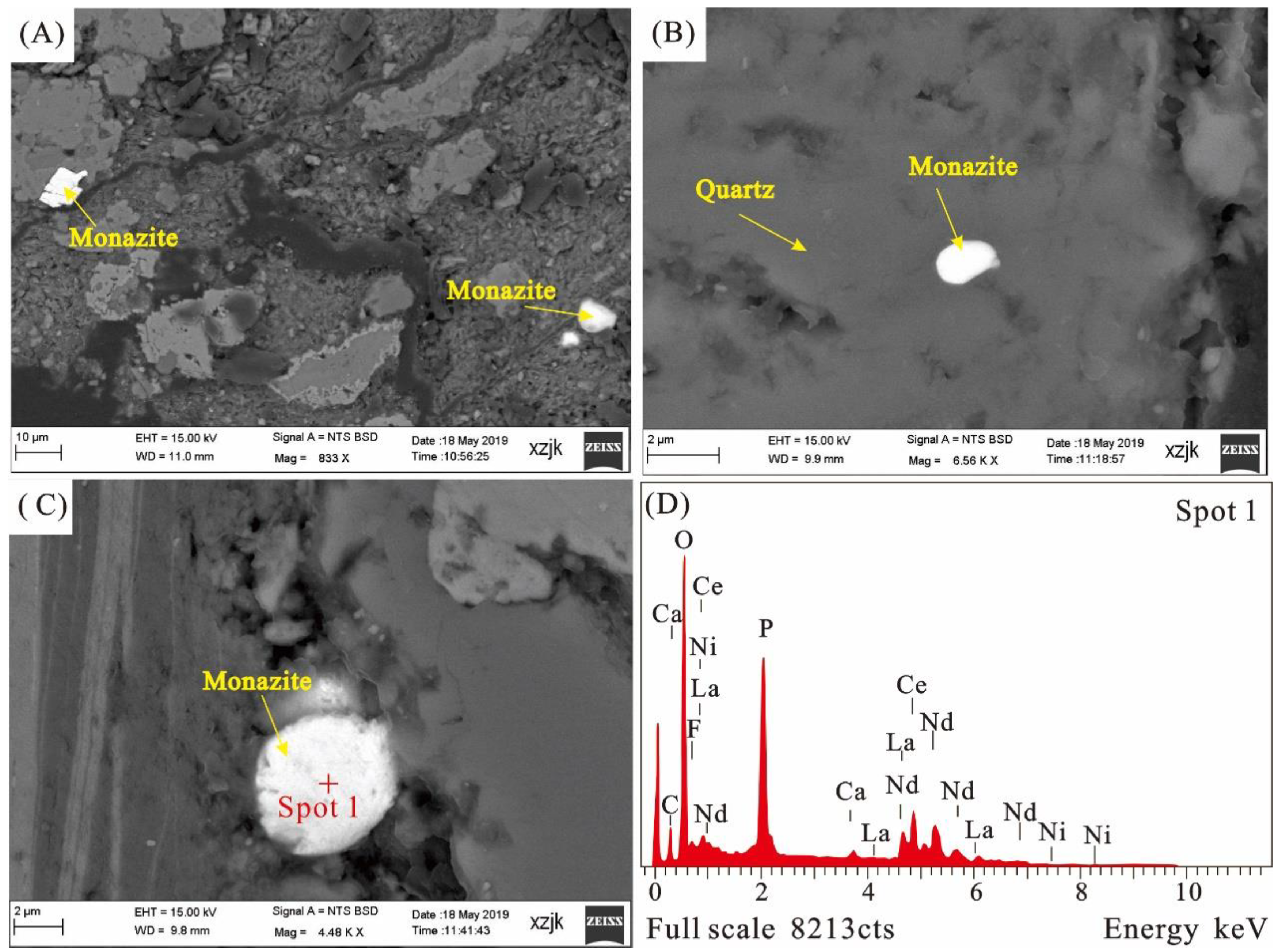
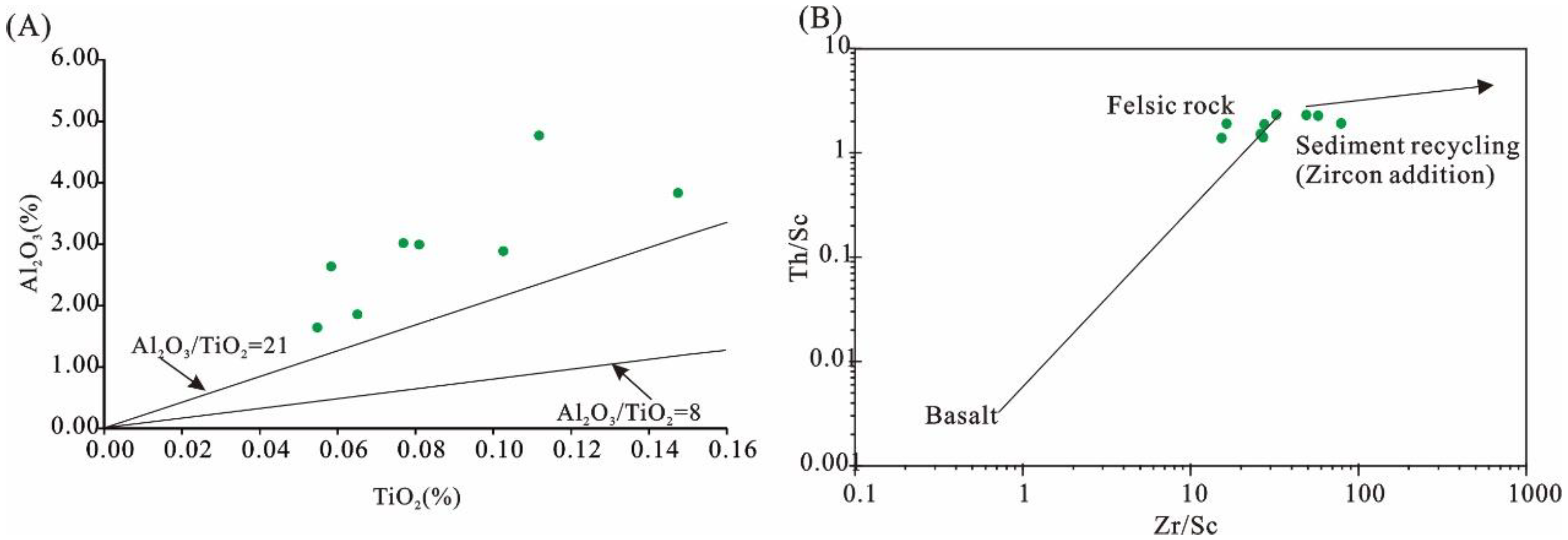
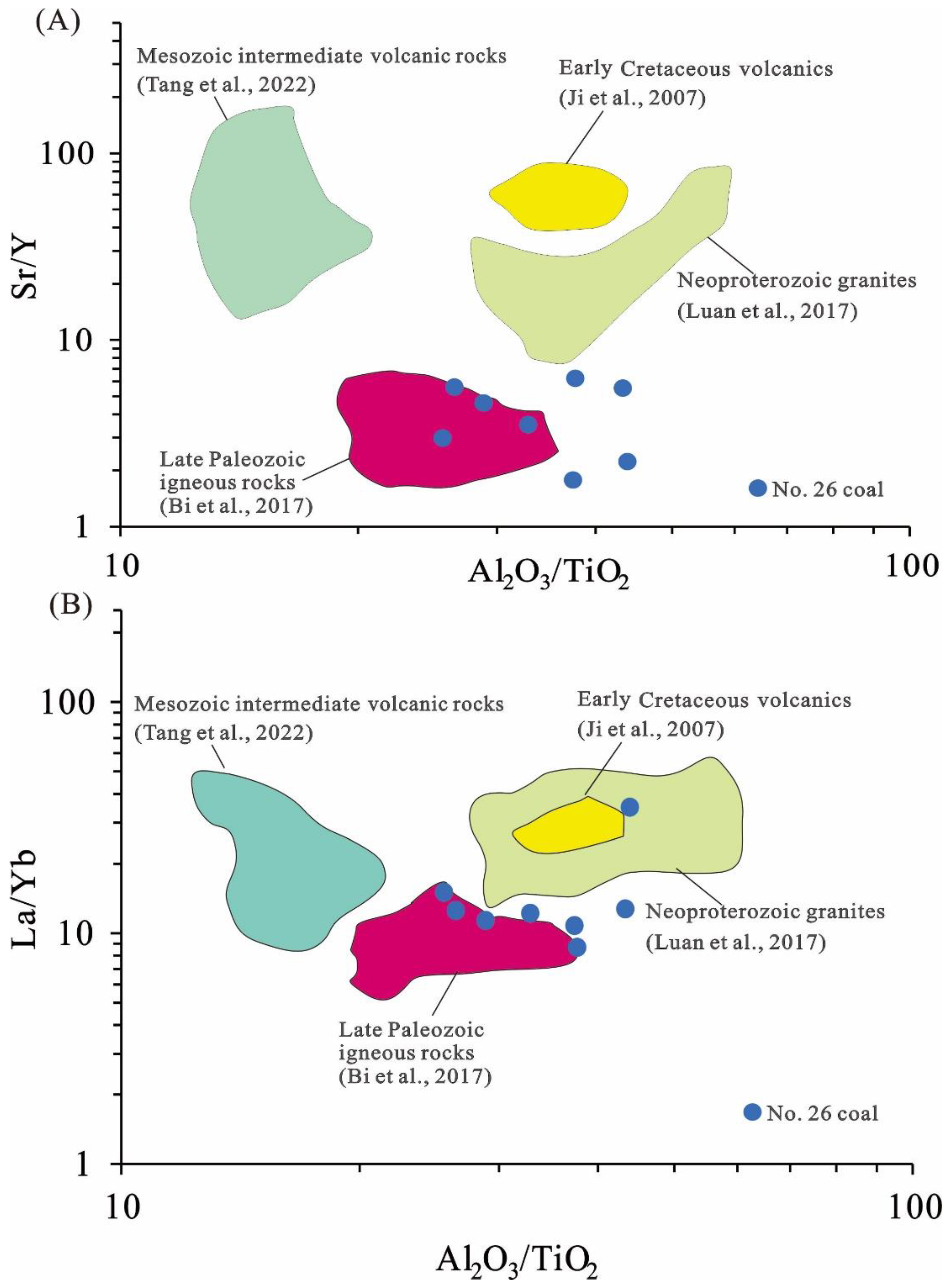

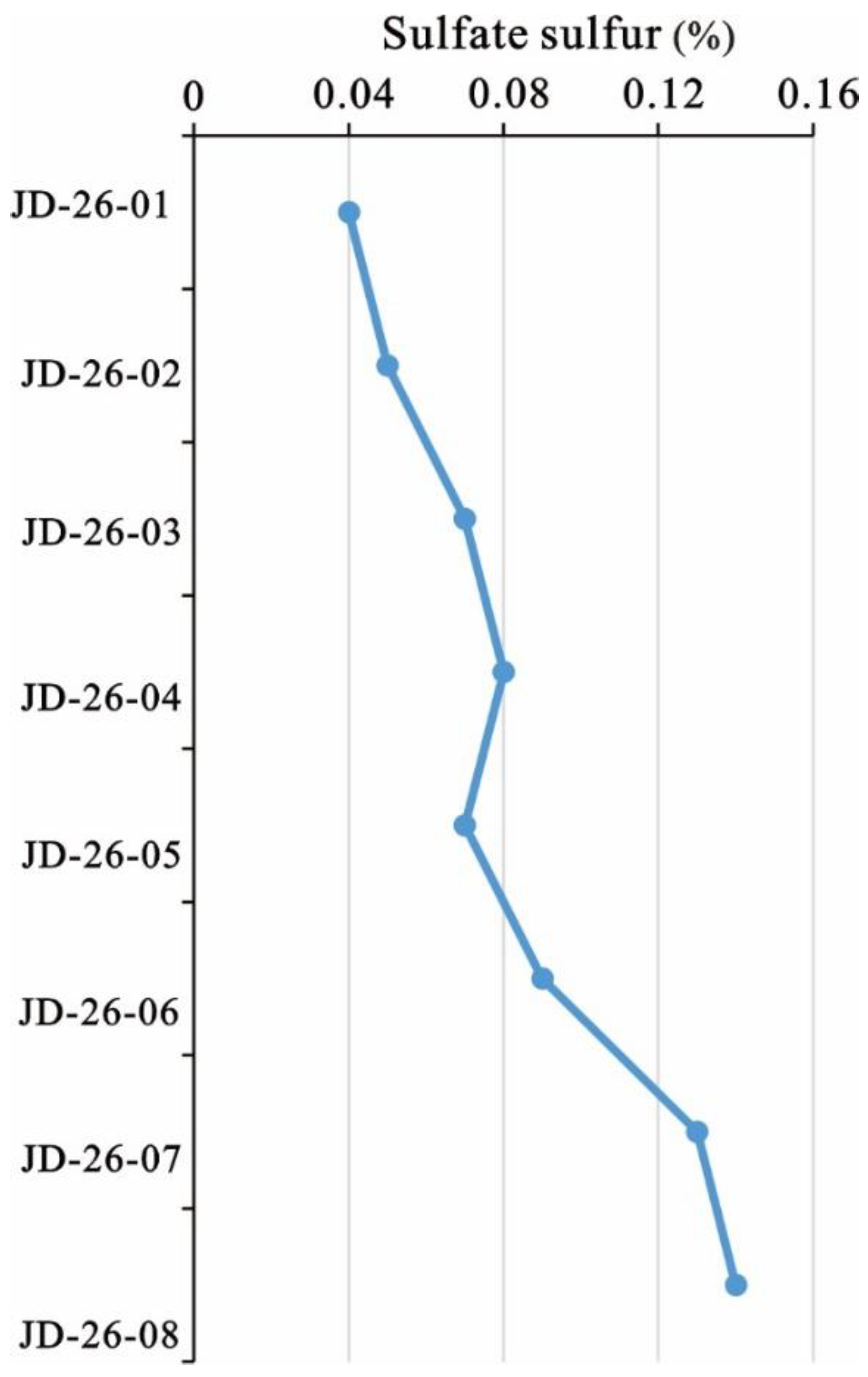
| Sample | Mad | Ad | Vdaf | Total Sulfur | Pyritic Sulfur | Sulfate Sulfur | Organic Sulfur |
|---|---|---|---|---|---|---|---|
| JD-26-01 | 3.1 | 12.6 | 36.2 | 0.54 | 0.27 | 0.04 | 0.23 |
| JD-26-02 | 2.4 | 13.4 | 37.2 | 0.57 | 0.02 | 0.05 | 0.50 |
| JD-26-03 | 2.4 | 17.5 | 38.8 | 0.57 | 0.02 | 0.07 | 0.48 |
| JD-26-04 | 2.2 | 12.1 | 38.6 | 0.72 | 0.43 | 0.08 | 0.20 |
| JD-26-05 | 2.3 | 8.6 | 37.3 | 0.58 | 0.31 | 0.07 | 0.20 |
| JD-26-06 | 2.3 | 9.7 | 37.9 | 0.66 | 0.33 | 0.09 | 0.24 |
| JD-26-07 | 1.9 | 12.4 | 38.3 | 0.62 | 0.35 | 0.13 | 0.14 |
| JD-26-08 | 2.2 | 17.6 | 41.1 | 0.70 | 0.44 | 0.14 | 0.11 |
| Sample | Vitrinite | Inertinite | Liptinite | Mineral | ||||||||||||||||||
|---|---|---|---|---|---|---|---|---|---|---|---|---|---|---|---|---|---|---|---|---|---|---|
| T | CT | CD | VD | CG | T-V | F | SF | Mic | ID | T-I | Sp | Cut | Sub | Res | Bit | T-L | Clays | Sulfide Minerals | Carbonate Minerals | Silica Minerals | Total Minerals | |
| JD-26-01 | 11.1 | 38.7 | 26.6 | 0.5 | 1.0 | 77.9 | 0.5 | 14.6 | - | 2.0 | 17.1 | 0.5 | 0.5 | - | - | 0.5 | 1.5 | 0.5 | 1.0 | 1.5 | 0.5 | 3.5 |
| JD-26-02 | 19.2 | 29.8 | 31.8 | 0.5 | 0.5 | 81.8 | 0.5 | 7.6 | - | 1.0 | 9.1 | 1.5 | - | - | 0.5 | - | 2.0 | 2.5 | - | 3.5 | 1.0 | 7.1 |
| JD-26-03 | 10.5 | 37.1 | 38.1 | - | 1.9 | 87.6 | 1.9 | 3.8 | - | 1.9 | 7.6 | 1.0 | 0.5 | - | - | - | 1.4 | 2.4 | - | - | 1.0 | 3.3 |
| JD-26-04 | 8.0 | 40.3 | 34.3 | 1.0 | 2.0 | 85.6 | 0.5 | 4.5 | 0.5 | 1.0 | 6.5 | 1.5 | - | - | 0.5 | 0.5 | 2.5 | 2.5 | 0.5 | 1.0 | 1.5 | 5.5 |
| JD-26-05 | 11.0 | 49.8 | 27.8 | - | 3.8 | 92.3 | - | 3.4 | - | 0.5 | 3.8 | 1.0 | 0.5 | - | - | - | 1.4 | - | 0.5 | 1.9 | - | 2.4 |
| JD-26-06 | 15.1 | 40.6 | 31.8 | - | 3.7 | 91.2 | 1.0 | 4.7 | 0.5 | - | 6.3 | 0.5 | - | 0.5 | - | - | 1.0 | 0.5 | - | 1.0 | - | 1.6 |
| JD-26-07 | 9.5 | 39.5 | 35.0 | - | 2.0 | 86.0 | 3.0 | 5.0 | - | 0.5 | 8.5 | 1.0 | 0.5 | - | 0.5 | - | 2.0 | 1.5 | - | 1.0 | 1.0 | 3.5 |
| JD-26-08 | 6.6 | 26.5 | 39.8 | - | 3.1 | 76.0 | 0.5 | 4.1 | - | 2.0 | 6.6 | 4.6 | - | - | - | 1.0 | 5.6 | 4.6 | - | 5.6 | 1.5 | 11.7 |
| Sample | LOI | SiO2 | TiO2 | Al2O3 | Fe2O3 | MgO | CaO | MnO | Na2O | K2O | SiO2/Al2O3 | Al2O3/TiO2 |
|---|---|---|---|---|---|---|---|---|---|---|---|---|
| JD-26-01 | 87.41 | 7.35 | 0.08 | 2.99 | 0.99 | 0.22 | 0.56 | 0.03 | 0.03 | 0.33 | 2.46 | 36.93 |
| JD-26-02 | 86.65 | 7.75 | 0.08 | 3.01 | 1.41 | 0.22 | 0.49 | 0.04 | 0.04 | 0.3 | 2.57 | 39.15 |
| JD-26-03 | 82.47 | 10.94 | 0.11 | 4.76 | 1.04 | 0.15 | 0.09 | 0.01 | 0.05 | 0.38 | 2.3 | 42.61 |
| JD-26-04 | 87.93 | 7.64 | 0.06 | 2.63 | 1.32 | 0.12 | 0.07 | 0.02 | 0.03 | 0.16 | 2.9 | 45.15 |
| JD-26-05 | 91.37 | 4.8 | 0.05 | 1.64 | 1.68 | 0.16 | 0.11 | 0.04 | 0.02 | 0.11 | 2.93 | 29.92 |
| JD-26-06 | 90.35 | 5.44 | 0.07 | 1.85 | 1.76 | 0.16 | 0.14 | 0.07 | 0.03 | 0.14 | 2.93 | 28.48 |
| JD-26-07 | 87.64 | 7.52 | 0.1 | 2.88 | 1.38 | 0.16 | 0.07 | 0.05 | 0.04 | 0.16 | 2.61 | 28.1 |
| JD-26-08 | 82.38 | 9.56 | 0.15 | 3.83 | 3.35 | 0.25 | 0.06 | 0.14 | 0.04 | 0.25 | 2.5 | 25.96 |
| Average | 7.63 | 0.09 | 2.95 | 1.62 | 0.18 | 0.20 | 0.05 | 0.04 | 0.23 | 2.65 | 34.54 | |
| China a | 8.47 | 0.33 | 5.98 | 4.85 | 0.22 | 1.23 | 0.02 | 0.16 | 0.19 | 1.42 | 18.12 |
| Sample | LREY | MREY | HREY | REY | LaN/LuN | LaN/SmN | GdN/LuN | EuN/EuN * | CeN/CeN * | δY |
|---|---|---|---|---|---|---|---|---|---|---|
| JD-26-R | 255.1 | 70.9 | 15.0 | 340.9 | 0.99 | 1.07 | 0.73 | 0.72 | 1.17 | 1.33 |
| JD-26-01 | 112.6 | 37.5 | 6.8 | 157.0 | 0.96 | 1.24 | 0.63 | 0.43 | 1.06 | 1.67 |
| JD-26-02 | 28.6 | 9.2 | 1.8 | 39.6 | 0.90 | 1.01 | 0.74 | 0.66 | 1.15 | 1.57 |
| JD-26-03 | 44.4 | 9.0 | 2.0 | 55.4 | 1.13 | 1.14 | 0.73 | 0.53 | 1.19 | 1.35 |
| JD-26-04 | 151.9 | 19.5 | 3.3 | 174.6 | 3.72 | 1.80 | 1.73 | 0.70 | 1.05 | 1.47 |
| JD-26-05 | 36.1 | 9.0 | 1.8 | 46.9 | 1.16 | 1.18 | 0.75 | 0.55 | 1.11 | 1.40 |
| JD-26-06 | 26.0 | 6.8 | 1.3 | 34.1 | 1.09 | 1.05 | 0.78 | 0.48 | 1.11 | 1.39 |
| JD-26-07 | 39.6 | 9.7 | 2.0 | 51.2 | 0.92 | 0.82 | 0.81 | 0.57 | 1.21 | 1.32 |
| JD-26-08 | 69.7 | 13.7 | 2.7 | 86.0 | 1.34 | 1.09 | 0.92 | 0.64 | 1.23 | 1.27 |
| JD-26-F | 279.5 | 41.6 | 6.7 | 327.8 | 2.67 | 1.57 | 1.40 | 0.66 | 1.14 | 1.52 |
Publisher’s Note: MDPI stays neutral with regard to jurisdictional claims in published maps and institutional affiliations. |
© 2022 by the authors. Licensee MDPI, Basel, Switzerland. This article is an open access article distributed under the terms and conditions of the Creative Commons Attribution (CC BY) license (https://creativecommons.org/licenses/by/4.0/).
Share and Cite
Wei, Y.; He, W.; Qin, G.; Wang, A.; Cao, D. Mineralogy and Geochemistry of the Lower Cretaceous Coals in the Junde Mine, Hegang Coalfield, Northeastern China. Energies 2022, 15, 5078. https://doi.org/10.3390/en15145078
Wei Y, He W, Qin G, Wang A, Cao D. Mineralogy and Geochemistry of the Lower Cretaceous Coals in the Junde Mine, Hegang Coalfield, Northeastern China. Energies. 2022; 15(14):5078. https://doi.org/10.3390/en15145078
Chicago/Turabian StyleWei, Yingchun, Wenbo He, Guohong Qin, Anmin Wang, and Daiyong Cao. 2022. "Mineralogy and Geochemistry of the Lower Cretaceous Coals in the Junde Mine, Hegang Coalfield, Northeastern China" Energies 15, no. 14: 5078. https://doi.org/10.3390/en15145078






